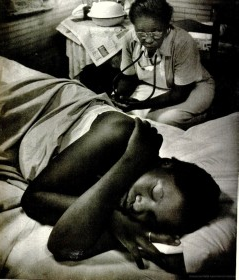About the Photoessay
In 1951, Life Magazine was at it’s best and this issue had one of the best photographic essays ever by W. Eugene Smith. The 12 page story is titled “Nurse Midwife Maude Callen Eases Pain of Birth and Death” The story follows Maude and her work in Pineville, South Carolina (Berkley County) and takes you on “Maude’s 16-Hour Day.” In 1951 “There are only nine trained Midwives in South Carolina and 300 in the nation” and Maude was one of the 20,000 common midwives practicing. This is a wonderful story with pictures of a way of life that has slipped by.
About the Photographer
W. Eugene Smith (William Eugene Smith), 1918-78, American photojournalist, is considered one of the principal masters of modern photojournalism. The distorted newspaper coverage of his father’s suicide made him determined to seek absolute personal honesty in his own documentary work. After a short time on the staff of Newsweek, he freelanced for many leading magazines, including Life, Collier’s,and Harper’s Bazaar, and for the New York Times. He worked with miniature (35 mm) cameras and developed an innovative flash technique that enabled him to produce indoor photographs having the appearance of natural or lamp light. Smith’s photographic record of events in the Pacific theater of World War IIis ranked among the grimmest and most powerful visual indictments of war. Severely wounded in 1945, he was unable to work for two years. The first photograph he made upon recuperation (of his two children walking toward a sunlit area on a wooded path) was chosen as the final work in the “Family of Man” exhibition (Mus. of Modern Art, New York City; 1955). From 1947 to 1954 Smith worked full time for Lifecreating a series of major photo essays, including “Trial by Jury” (1948), “Country Doctor” (1948), “Nurse Midwife” (1951), “The Reign of Chemistry” (1953), and “A Man of Mercy” (concerning Albert Schweitzer, 1954). With a Guggenheim Fellowship he created his celebrated “Pittsburgh” essay (1956). In 1963 Smith began an intensive photographic study of Japan. While documenting the maiming effects of mercury poisoning from factory pollution on the residents of the fishing village of Minamata (1971-73), he was brutally beaten; as a result he lost his sight temporarily in 1974.Smith said, “Photography is a small voice, at best, but sometimes-just sometimes-one photograph or a group of them can lure our senses to awareness. Much depends on the viewer; in some, photographs can summon enough emotion to be a catalyst to thought. Someone-or perhaps many-among us may be influenced to heed reason, to find a way to right that which is wrong, and may even search for a cure to an illness. The rest of us may perhaps feel a greater sense of understanding and compassion for those whose lives are alien to our own. Photography is a small voice. I believe in it. If it is well conceived, it sometimes works.”






